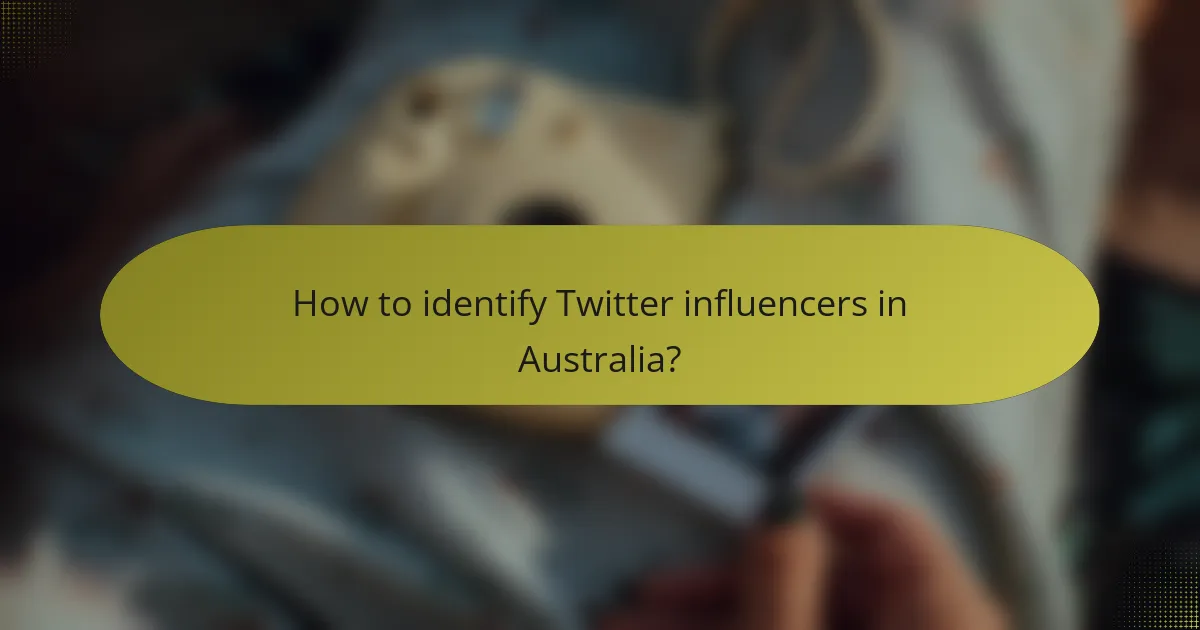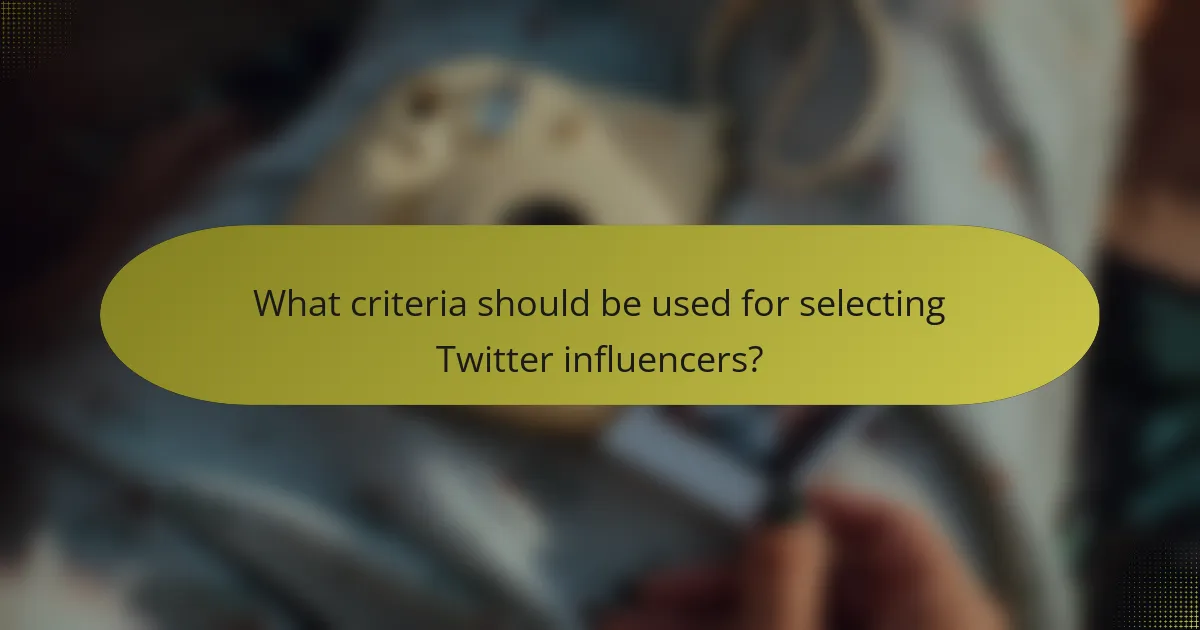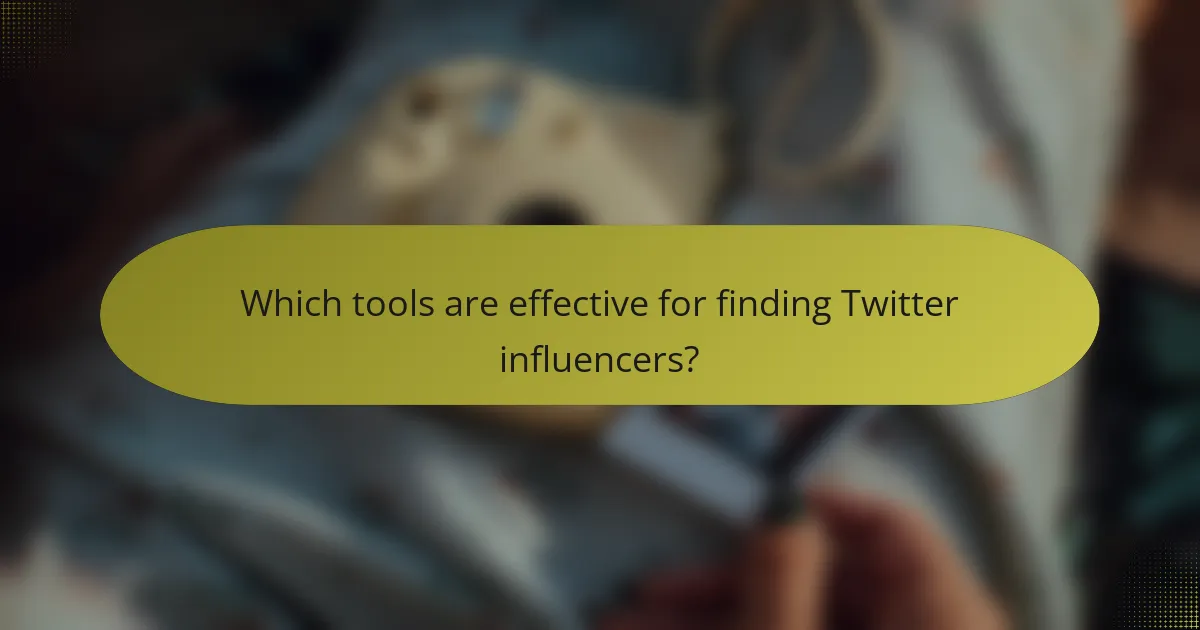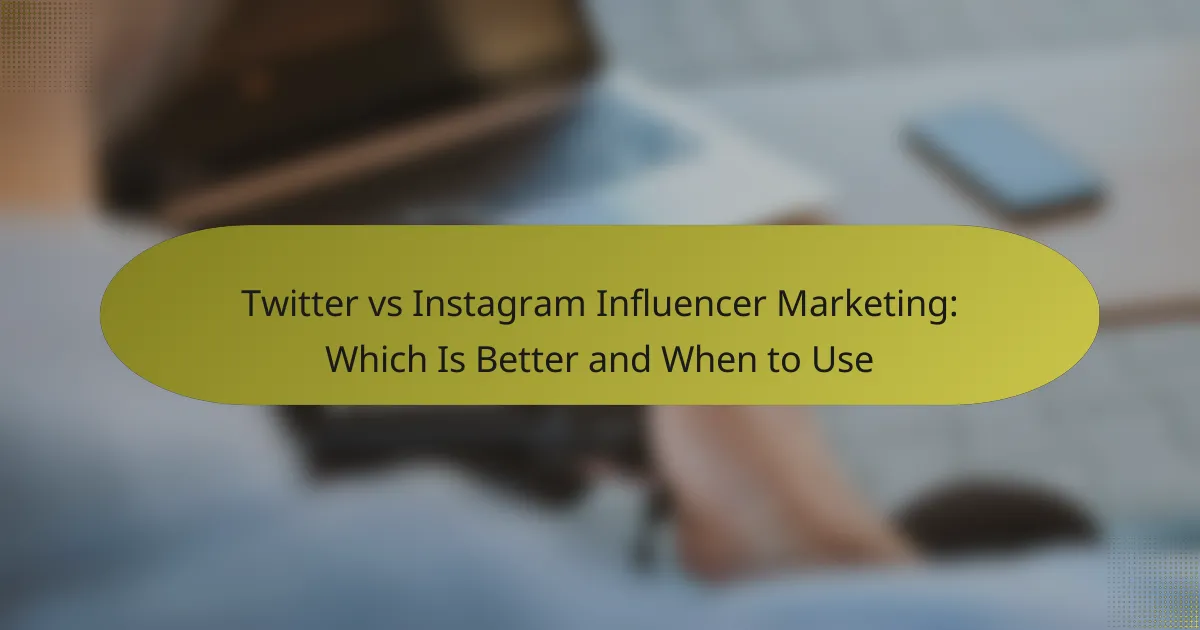Identifying Twitter influencers is crucial for brands looking to enhance their online presence and engage effectively with their target audience. By evaluating criteria such as reach, engagement rates, and content quality, businesses can pinpoint the most relevant voices in their niche. Utilizing specialized tools can further streamline this process, ensuring that brands connect with influencers who align with their goals and resonate with their audience.

How to identify Twitter influencers in Australia?
Identifying Twitter influencers in Australia involves assessing their reach, engagement, and relevance to your target audience. Focus on metrics such as follower count, interaction rates, and the quality of their content to find the most impactful voices in your niche.
Use Twitter’s advanced search
Twitter’s advanced search feature allows you to filter tweets by keywords, hashtags, and user accounts, making it easier to find influencers relevant to your industry. You can specify location parameters to focus on Australian users, ensuring that the influencers you identify resonate with your local audience.
To use this tool effectively, enter specific keywords related to your niche and select the “From these accounts” option to narrow down results to known influencers. This method helps in discovering both established and emerging voices in your field.
Analyze follower engagement metrics
Engagement metrics, such as likes, retweets, and replies, provide insight into how actively an influencer’s audience interacts with their content. Look for influencers whose engagement rates are higher than average, as this indicates a more dedicated and responsive following.
A good rule of thumb is to consider influencers with engagement rates above 1-3% as potentially impactful. Tools like Twitter Analytics or third-party platforms can help you track these metrics easily.
Check influencer marketing platforms
Influencer marketing platforms like Upfluence, AspireIQ, and Traackr can streamline the process of identifying Twitter influencers in Australia. These platforms provide databases of influencers along with detailed analytics on their performance and audience demographics.
When using these tools, filter by location and niche to find influencers who align with your brand values and target market. This can save time and ensure you connect with the right individuals for your marketing campaigns.
Utilize social listening tools
Social listening tools, such as Hootsuite or Brandwatch, allow you to monitor conversations around specific topics or hashtags on Twitter. By tracking these discussions, you can identify key influencers who are driving engagement and shaping opinions in your industry.
Set up alerts for relevant keywords and analyze who is frequently mentioned or engaged in these conversations. This approach not only helps in finding influencers but also provides insights into trending topics and audience sentiments in Australia.

What criteria should be used for selecting Twitter influencers?
Selecting Twitter influencers requires evaluating specific criteria that align with your brand’s goals and target audience. Key factors include relevance to your niche, engagement rates, follower demographics, and content quality.
Relevance to your niche
Relevance is crucial when selecting Twitter influencers, as their content should resonate with your brand’s message and target audience. Look for influencers who frequently discuss topics related to your industry or sector.
To assess relevance, review their recent tweets and interactions. An influencer who regularly engages with your niche will likely have a more authentic connection with their followers, which can enhance your brand’s visibility.
Engagement rate
Engagement rate is a key metric that indicates how actively an influencer’s audience interacts with their content. This can include likes, retweets, and replies, and is often expressed as a percentage of total followers.
A good engagement rate typically ranges from 1% to 5%, but this can vary by industry. Influencers with higher engagement rates often have more loyal followers, making them more effective for promotional campaigns.
Follower demographics
Understanding an influencer’s follower demographics is essential for ensuring that their audience matches your target market. This includes age, gender, location, and interests.
Tools like Twitter Analytics or third-party platforms can provide insights into follower demographics. Aim for influencers whose audience aligns with your ideal customer profile to maximize the impact of your marketing efforts.
Content quality
Content quality reflects the value and relevance of what an influencer shares. High-quality content is typically well-researched, visually appealing, and engages the audience effectively.
Review the influencer’s past tweets for clarity, creativity, and consistency in messaging. Influencers who produce high-quality content are more likely to maintain audience interest and foster trust, which can benefit your brand’s reputation.

Which tools are effective for finding Twitter influencers?
Several tools can effectively help you identify Twitter influencers based on their reach, engagement, and relevance to your niche. Utilizing these tools allows you to streamline your search and focus on influencers who align with your brand’s goals.
BuzzSumo
BuzzSumo is a powerful tool for discovering influencers by analyzing content performance across social media platforms, including Twitter. You can search for specific topics or keywords to find users who consistently share popular content, making it easier to identify potential influencers in your industry.
To get started, enter a relevant keyword and filter the results by social network. You can also assess each influencer’s engagement metrics, such as retweets and likes, to gauge their influence effectively.
Followerwonk
Followerwonk specializes in Twitter analytics, allowing you to search bios, compare users, and analyze followers. This tool is particularly useful for finding influencers based on their interests and expertise, as you can search for keywords within user bios.
Once you identify potential influencers, you can analyze their followers and engagement rates to ensure they have a genuine audience. This insight helps you select the right individuals who can amplify your message.
Hootsuite
Hootsuite is primarily known for social media management but also offers features to identify influencers. You can monitor specific keywords and hashtags related to your brand, allowing you to spot influential users who are actively engaging in relevant conversations.
By setting up streams for specific topics, you can track interactions and identify users who frequently contribute valuable insights. This approach helps you build a list of potential influencers who resonate with your target audience.
Traackr
Traackr is an influencer marketing platform that provides comprehensive insights into influencer relationships and performance. It allows you to discover influencers based on various criteria, including reach, relevance, and resonance within your niche.
Using Traackr, you can create customized lists of influencers and analyze their impact on your campaigns. This tool is particularly beneficial for brands looking to establish long-term partnerships with influencers who align with their values and goals.

How to measure engagement with Twitter influencers?
Measuring engagement with Twitter influencers involves analyzing various metrics that reflect their audience’s interaction with content. Key indicators include retweets, likes, mentions, replies, and click-through rates, which together provide a comprehensive view of an influencer’s impact.
Track retweets and likes
Retweets and likes are fundamental metrics for gauging engagement on Twitter. A high number of retweets indicates that followers find the content valuable enough to share, while likes reflect approval and interest. Aim for influencers with a consistent pattern of retweets and likes, ideally in the hundreds or thousands, depending on their follower count.
When assessing these metrics, consider the context of the content. Seasonal trends or specific campaigns may temporarily boost engagement, so look for sustained performance over time rather than isolated spikes.
Monitor mentions and replies
Mentions and replies provide insight into how actively an influencer engages with their audience. A high volume of mentions suggests that followers are discussing the influencer’s content, while replies indicate direct interaction. Aim for influencers who not only receive mentions but also respond to their audience, fostering a two-way conversation.
To effectively monitor these interactions, use tools that track mentions in real-time. This allows you to assess the sentiment of the conversations and identify any recurring themes or questions from the audience.
Analyze click-through rates
Click-through rates (CTR) measure how often users click on links shared by influencers, reflecting their ability to drive traffic. A good CTR typically ranges from 1% to 5%, depending on the industry and the type of content shared. Influencers with higher CTRs are more effective at engaging their audience and prompting action.
To analyze CTR, use URL shorteners or tracking tools that provide insights into how many clicks a link receives. This data can help you evaluate which influencers are most successful at converting engagement into tangible results, such as website visits or sign-ups.









